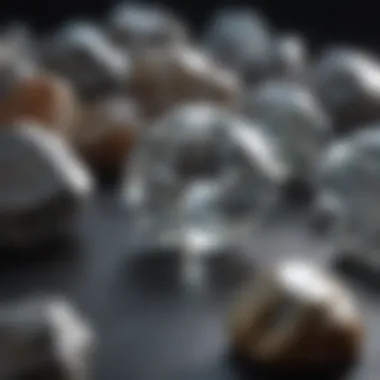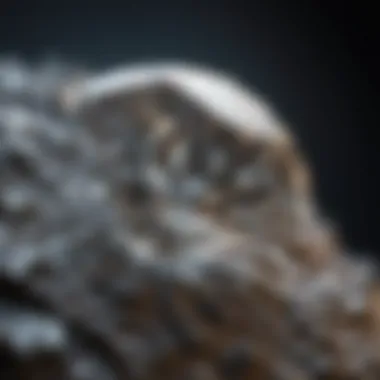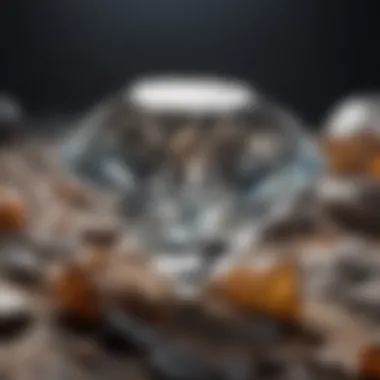How to Identify a Raw Diamond: A Comprehensive Guide


Intro
Identifying raw diamonds can be a complex task, often requiring deep knowledge of geology and gemology. Yet, many enthusiasts in the field of mineral collecting find this pursuit rewarding, as uncovering a diamond is both thrilling and intellectually engaging. In this guide, we will explore several methodologies for identifying raw diamonds, including their distinct geological context, visual attributes, and physical characteristics.
Understanding the significance of identification is crucial. Several factors influence how raw diamonds are distinguished from similar-looking minerals, such as quartz or calcite. This guide serves to empower collectors and hobbyists with practical techniques that promote confidence in identification. We will also discuss common mistakes encountered in the field. Our aim is to build a bridge for both the novice and seasoned collector toward a more sophisticated appreciation of raw diamonds.
Featured Collectible of the Month
Overview
The featured collectible for this month is the Brazilian Diamond, renowned as both a collector's gem and a focal point in the study of diamonds. Its unique formation and geographical distribution provide a fascinating backdrop to its characterization. Brazilian diamonds are typically found in riverbeds, showcasing a variety of sizes and clarity. This background enhances their collectibility and appeal in the gemology community.
Historical Significance
Brazil has a rich legacy in diamond mining, particularly during the 18th century. The Brazilian Diamond Rush established the country as a leading source of diamonds worldwide. Understanding the historical context adds layers to the appreciation of Brazilian diamonds, as they symbolize a period of intense commercial and cultural exchange. Collectors often seek out these diamonds not just for their inherent beauty but also for their place in history.
Identification Techniques
Successfully identifying raw diamonds requires a combination of visual assessments and physical examinations. The following sections highlight various techniques that can lead to successful identification.
Visual Characteristics
When evaluating raw diamonds, consider these visual traits:
- Luster: Diamonds typically showcase a strong, reflective luster.
- Transparency: Unlike many minerals, raw diamonds can exhibit varying levels of clarity, often appearing translucent.
- Color: They can appear in multiple hues, including gray, yellow, and clear, though yellow can often indicate a lower quality.
- Shape: Natural diamonds usually possess an octahedral shape, possibly embedded in a rough matrix.
A comprehensive understanding of these characteristics can sharply reduce the risk of misidentification.
Resources for Identification
Utilizing accurate tools and resources is vital for effective identification. Here is a list of some useful references:
- Gemological Institute of America (GIA): Provides extensive resources about gem identification.
- Books on minerals: Such as "Gemstones of the World" by Walter Schumann, which offer insights into various minerals and gems.
- Online communities: Engaging in forums like Reddit can provide practical, user-generated insights and experiences.
"Proper identification is not only about recognizing a gem but understanding its place in geological history."
Keeping these resources handy can significantly bolster one’s ability to accurately identify raw diamonds.
By understanding these techniques deeply, one can become more adept at identifying raw diamonds, leading to a rewarding experience in the world of collecting.
Preface to Raw Diamonds
Understanding raw diamonds is not merely an academic pursuit; it is essential for collectors, hobbyists, and anyone engaged in geology or mineralogy. This introduction sets the stage for a deeper exploration of what constitutes a raw diamond. Knowing its physical characteristics, formation process, and geological context is crucial for identification and appreciation.
Definition of Raw Diamonds
A raw diamond refers to a diamond that has not been cut or polished. These gems are typically found in nature in their original crystalline form, often with a rough and unrefined appearance. Contrary to popular belief, raw diamonds can appear quite different from the sparkling versions seen in jewelry stores. Their natural state, usually characterized by a dull surface and irregular shape, presents a unique challenge for identification. However, recognizing a raw diamond is key for any serious collector or enthusiast in the field.
The Formation Process
The process of diamond formation occurs deep within the Earth's mantle over millions of years. Diamonds are formed under high temperature and pressure conditions, where carbon atoms bond in a crystal structure. This unique formation process distinguishes diamonds from other minerals.
- High Pressure and Temperature: Diamonds typically form at depths of at least 140 kilometers, where conditions pressure can exceed 725,000 pounds per square inch.
- Carbon Sources: The carbon that forms diamonds can originate from various sources, including organic material or carbon dioxide, which gets crystallized in the right environment.
The geological context and the specifics of diamond formation underscore their value and rarity, providing critical insight for anyone interested in identifying them.


Geological Context
Understanding the geological context of diamonds is key for anyone interested in identifying raw diamonds. This section provides a fundamental baseline that supports the identification processes detailed later in the guide. Knowing where diamonds originate can lead collectors to explore the right environments. Learning about the geological history of diamond formation will also help in recognizing features that are indicative of diamonds as opposed to other minerals.
Origin of Diamonds
Diamonds form deep within the Earth's mantle under conditions of extreme heat and pressure, typically at depths of about 140 to 190 kilometers. Their primary composition is carbon, but they require specific conditions to crystallize and grow. One interesting fact is that diamonds are not formed in volcanic eruptions but rather in kimberlite pipes. These pipes act as conduits bringing diamonds to the surface over millions of years. Understanding this geological process is crucial. It not only informs collectors where to search but also helps in recognizing the geological formations that are likely to contain diamonds.
Diamond Deposits Around the World
Diamonds are found globally, but significant deposits offer different environments and qualities. Major diamond-producing countries include:
- Russia: Home to the Mir and Udachny mines, Russia consistently leads in diamond production.
- Botswana: Renowned for high-quality diamonds, the Orapa mine is one of the largest.
- Canada: Emerging as a key player in diamond mining in the past few decades, notable mines include Ekati and Diavik.
- Australia: The Argyle mine was known for its pink diamonds before its closure in 2020.
These locations provide an insight to collectors regarding where to look for raw diamonds. Each deposit has unique characteristics influenced by its geological history, which helps in identification. Knowing the global landscape also aids in avoiding common pitfalls, as similar-looking stones may not always be diamonds.
Awareness of the geological context allows for more informed exploration, benefitting collectors in their pursuits.
Physical Properties of Diamonds
Understanding the physical properties of diamonds is essential when identifying raw diamonds. These properties provide critical insight into the material's characteristics and behavior. Knowing how to assess hardness, luster, transparency, and specific gravity can help distinguish diamonds from other minerals. Each of these attributes plays a significant role in the identification process and offers further assurance of authenticity.
Hardness and Durability
Diamonds are renowned for their hardness. They rank a perfect ten on the Mohs scale, making them the hardest known natural material. This unmatched hardness contributes to their durability. When identifying a raw diamond, testing its hardness against other minerals can help narrow down its authenticity. Many other gemstones and minerals, such as quartz or topaz, simply do not measure up.
The hardness of a diamond means it can scratch almost any other material. As a collector, you can perform a scratch test using materials of various hardness levels. It's vital to be cautious in this testing, as excessive pressure can cause damage.
Luster and Transparency
Luster refers to how a mineral reflects light. Diamonds exhibit a brilliant adamantine luster, which distinguishes them in the mineral world. When light strikes the surface of a raw diamond, it creates a remarkable sparkle. In contrast, most other minerals lack this level of brilliance.
Raw diamonds can be slightly opaque or even hazy. However, if you carefully observe the stone in light, you should notice a characteristic inclusiveness—a mix of light and dark areas. This contrasts with many other stones that may offer a more uniform appearance.
The transparency of a diamond plays a significant role in its identification. While examining a rough stone, look for clarity and the ability for light to pass through. Even slightly cloudy diamonds can reveal underwhelming transparency when compared to the clarity of other gemstones.
Specific Gravity
Specific gravity is a measure of density relative to water. Diamonds have a specific gravity of approximately 3.5. This relatively high density can help pinpoint diamonds among other minerals with lower specific gravity.
To test specific gravity accurately, you can use a simple water displacement method. Weigh the mineral and then submerge it in water to measure displaced water volume. This method can assist in confirming whether the observed specimen matches diamond's unique density.
Visual Characteristics to Identify Raw Diamonds
Identifying raw diamonds involves careful observation of various visual characteristics. These elements play an essential role in distinguishing diamonds from other minerals. Knowing what to look for increases the chance of correctly identifying raw diamonds, enhancing the experience for collectors and enthusiasts. Beyond mere appearances, these visual traits offer insight into the diamond’s origin and potential value.
Color Variations
Raw diamonds can present a spectrum of color variations. The common perception is that diamonds are colorless, but many raw diamonds display shades of yellow, brown, and even rare colors like blue or pink. Each color provides clues about the diamond's formation and its impurities. For instance, deep yellow to brown colors result from nitrogen impurities during formation.
When assessing color, the gradation of tint can significantly influence value. A completely colorless diamond ranks highly. However, even light hues can still be valuable due to their rarity. Note that some colors are particularly prized due to their striking appearance. Being attentive to these color nuances creates a more profound understanding of each specimen's uniqueness.
Surface Features
Examining surface features is crucial for identification. Raw diamonds often have a distinctive texture that can differ from other minerals. Look for natural markings such as the octahedral shape that characterizes diamonds. A diamond may display smooth, shiny surfaces alongside more coarse or rough areas. These contrasts can indicate natural wear or formation processes.
Scuffs and scratches can also provide valuable information. Each mark tells a story of the diamond's journey, possibly hinting at its geological history. One way to discern diamonds is by observing surface reflectivity. Diamonds tend to have a high luster, which sets them apart from many other minerals that may appear dull or matte.


"Surface characteristics can sometimes reveal more than the color, providing insights into the diamond's overall quality."
Crystal Structure
The crystal structure of raw diamonds is another key identifying feature. Diamonds crystallize in a cubic form, which is unique among minerals. Observing the arrangement of its edges and vertices is essential. Rough diamonds retain the octahedral shape, which can appear either sharp or slightly rounded. This geometric quality is a prime indicator of a true diamond as other materials may not exhibit the same clear crystalline structure.
Understanding crystal growth is also beneficial. Diamonds may show irregularities that can arise from growth in diverse environments. While some diamonds appear more uniform, others may have inclusions or irregular forms. All of these traits contribute to the identification process.
Being aware of how these visual characteristics interact enhances one's ability to identify raw diamonds accurately. Collectors often find joy in investigating the specific traits of each stone they encounter. Mastering the visual markers can elevate their collection or educational engagement.
Techniques for Testing Raw Diamonds
Identifying raw diamonds requires a careful and informed approach. Employing various techniques can significantly increase the chance of correctly discerning diamonds from other minerals. The importance of these testing methods lies in their practical application for rock and fossil collectors. Therefore, understanding these techniques becomes essential.
Visual Inspection Methods
The first step in testing raw diamonds often begins with visual inspection. This involves examining the stone closely for its physical appearance. Collectors should be mindful of the diamond's character. Luster, surface features, and color variations can all be indicators of a raw diamond.
- Luster: Diamonds typically exhibit a unique brilliance. Their reflective quality is distinct compared to other minerals. Observing the surface can reveal much.
- Surface features: Inspect for characteristics like inclusions or blemishes. Raw diamonds may display a rough surface with a somewhat dull appearance. This differs from polished stones, which often have a sparkling finish.
- Color: While diamonds are often colorless, they can present a range of hues. It is crucial to note any tints, as these can affect identification. Some raw diamonds may exhibit pale yellow, brown, or even rare colors like pink or blue. Understanding these visual aspects equips collectors to make more informed assessments.
Using Simple Tools
Using basic tools can enhance the identification process significantly. Simple instruments like a magnifying glass or a jeweler's loupe allow collectors to examine the stone in greater detail.
- Magnifying glass: This can reveal minor features that are not visible to the naked eye. Observing inclusions or grain patterns can show if the stone is indeed a diamond.
- Scratch test: While a more aggressive method, scratching the surface of a material will differ by type. Diamonds are known for their hardness. Testing with materials like quartz can be insightful. If the stone scratches quartz, it might be a diamond.
Magnification in Examination
Magnification plays a vital role in diamond identification. Utilizing higher magnification allows for a deeper examination of the diamond. With tools such as a microscope, you can scrutinize the stone's internal characteristics more closely.
- Internal features: Many diamonds have unique inclusions known as "blemishes" or “graining.” These characteristics can differentiate genuine diamonds from synthetics or other minerals.
- Reflection and refraction: Watching how light interacts with the stone under magnification can also provide clues. Diamonds have a unique sparkle due to their exceptional optical properties.
"Using magnification, one can see the true nature of the stone, revealing secrets hidden to the untrained eye."
Common Mistakes in Identification
Identifying raw diamonds can be a complex process. Mistakes in identification can lead to significant disappointment and financial loss. It's vital for collectors and hobbyists to recognize common pitfalls in the identification process. Awareness of these mistakes can enhance both the effectiveness and enjoyment of searching for raw diamonds. A clear understanding of what to watch out for will bolster confidence in making accurate identifications.
Misidentifying Other Minerals
One of the most frequent errors is the misidentification of other minerals as diamonds. Several minerals, such as quartz and cubic zirconia, can share similar physical characteristics with diamonds. For example, both quartz and diamonds can exhibit brilliance and clarity. However, their hardness levels vary significantly. Diamonds are rated 10 on the Mohs scale, while quartz sits at a mere 7. Misidentifying these minerals can result in overlooking genuine diamonds.
To avoid this, collectors should consider performing thorough scratch tests. Using a material that is known to be softer than diamond can help verify the material's authenticity. For example, trying to scratch quartz with a suspected diamond will yield conclusive results.
It’s also wise to utilize a loupe or microscope to examine the internal features of the specimen. Many other minerals lack the inclusions or crystal structures distinctive to diamonds. Keeping a reliable reference book or resource on hand can assist in differentiating diamond from impostors.
Overlooking Key Indicators
Another serious mistake occurs when key indicators of a raw diamond are overlooked. Raw diamonds often present certain visual characteristics that are critical to identify. These include the rough surface texture and the absence of facets, which are commonly associated with polished gemstones.
Common indicators such as the unique "thumbprint" feature—a small indentation that can resemble a fingerprint—are essential to note. Failing to recognize these features can result in confusion and mistaken identity.
Additionally, collectors should be cautious about the effects of lighting. Viewing a specimen under poor lighting conditions can distort the true colors and features of the stone, leading to erroneous conclusions. Good practice involves examining the stone under various types of lighting, including natural sunlight and incandescent light.
Moreover, some collectors might neglect to consider the overall context of where the stone was found. Being aware of local geological characteristics can greatly aid identification. If a gemstone is discovered in an area with no known diamond deposits, skepticism is warranted.


By addressing these common mistakes, collectors can enhance their identification skills, ensuring that their pursuit of raw diamonds is both successful and rewarding. Becoming familiar with both the potential errors and correct identification techniques is fundamental to the journey of any collector.
Case Studies of Raw Diamond Findings
Examining case studies of raw diamond findings offers insights that are crucial for both novice and experienced collectors. These narratives not only illustrate the practical aspects of identifying raw diamonds but also highlight the historical and geographical contexts in which these diamonds were found. Understanding these cases enriches the reader’s knowledge and appreciation for the process of finding and identifying raw diamonds.
Each case study can act as a practical lesson that demonstrates both the successes and challenges faced by those searching for these valuable minerals. By analyzing noteworthy discoveries, collectors can better equip themselves with the skills needed to verify authenticity in their pursuits.
Notable Finds and Their Stories
One prominent case is the discovery of the Cullinan Diamond, found in South Africa in 1905. Weighing an astonishing 3,106 carats, it is the largest gem-quality diamond ever mined. The story of its discovery involves a miner uncovering it in a limestone deposit, which serves as a reminder of the unexpected places where raw diamonds can be found. The rough diamond was later split into several smaller stones, most famously the Great Star of Africa, which is part of the British Crown Jewels.
Another interesting example is the Argyle Diamond Mine in Australia. Known for producing a significant amount of pink and red diamonds, Argyle's raw finds have reshaped market expectations about diamond color. The mine operated for over 35 years, unveiling various fascinating stories about the methods used in extraction and the ensuing cultural impacts in the region.
Lessons Learned from Each Example
From these notable cases, several lessons emerge:
- Location Matters: Understanding the geological context of a diamond find is critical. The features of the land, environmental factors, and historical data contribute significantly to diamond identification.
- Authenticity Verification: The stories of these diamonds stress the importance of verification methods. Collectors should develop an acute eye for detail and learn to distinguish between diamonds and imitations.
- Market Dynamics: The Argyle mine findings reveal that the diamond market can be influenced by raw diamond characteristics, such as color and clarity. Understanding these trends can assist collectors in making informed decisions.
Learning from historical discoveries not only helps collectors refine their identification skills but also emphasizes the ongoing importance of ethical practices in the diamond industry. As collectors engage with these stories, they come to appreciate the rich tapestry of the diamond's journey, from its natural setting to its eventual placement in jewelry or collections.
Ethical Considerations in Collecting
Understanding the ethical implications of collecting raw diamonds is crucial for any enthusiast or professional in the field. Raw diamond collection can sometimes lead to significant environmental and social consequences, particularly if not approached thoughtfully. Ethical considerations ensure that collectors engage in practices that promote sustainability and respect for both the environment and local communities.
Impact of Diamond Mining
The impact of diamond mining on ecosystems and local communities cannot be understated. Traditional diamond mining processes, especially in regions lacking rigorous regulation, often lead to deforestation, soil degradation, and water pollution. These environmental issues can have long-lasting effects on biodiversity as habitats are destroyed. Moreover, illegal or unregulated mining operations can result in human rights abuses, displacing indigenous populations and disrupting their livelihoods.
Key points regarding the impact include:
- Ecosystem Damage: Mining projects frequently lead to habitat destruction, affecting flora and fauna.
- Water Contamination: The use of chemicals in mining can pollute local water sources, harming both wildlife and human populations.
- Social Disruption: Communities may face displacement and loss of cultural heritage due to mining activities.
By acknowledging these impacts, collectors can make informed decisions on where and how to acquire their specimens. Choosing ethically sourced diamonds, which follow sustainable practices, is a significant step towards reducing these negative effects.
Sustainability in Collecting Practices
Sustainability in the collection of raw diamonds involves several considerations aimed at minimizing ecological damage and promoting responsible sourcing. Adopting sustainable practices ensures that diamond acquisition does not compromise the welfare of ecosystems or the communities involved in mining.
Some practices that promote sustainability include:
- Choosing Reputable Sources: Engaging with suppliers who comply with ethical mining standards ensures diamonds are sourced responsibly.*
- Supporting Local Communities: Purchasing from cooperatives or local miners who adhere to fair practices can help support the local economy while protecting community rights.
- Encouraging Transparency: Seek documentation and traceability from sellers to understand the origin of the diamonds and the practices used in their collection.
Ethical collection is not just about where diamonds come from; it is about ensuring that the benefits reach the right communities while safeguarding the environment.
Culmination
In this article, the examination of how to identify raw diamonds has been thorough, addressing various aspects that are critical for any rock and fossil collector. Understanding the significance of identification techniques is paramount for collectors in their pursuits. It enhances one’s ability to discern raw diamonds from other minerals, thus safeguarding both time and resources.
Recap of Key Identification Techniques
To effectively identify raw diamonds, several techniques have been discussed. The processes include:
- Visual inspection: Observing immediate characteristics such as color and surface features is essential. A keen eye can spot differences between diamonds and look-alikes, like quartz or other minerals.
- Physical tests: Employing methods to assess hardness and luster allows collectors to evaluate the diamond’s qualities practically. This can clarify its authenticity.
- Magnification: Utilizing tools like a jeweler’s loupe can reveal minute details that are critical in identification. This aids in observing the crystal structure and unique traits.
In summary, utilizing a combination of visual inspection, physical properties, and magnification techniques can significantly improve the accuracy of identifying raw diamonds.
Final Thoughts on Raw Diamond Identification
Identifying raw diamonds is not just about technical know-how; it ties into the broader appreciation for geology and natural resources. For collectors, honing these identification skills can lead to more rewarding finds as well as contribute to responsible collecting practices. The journey to becoming an expert does require practice and patience, but the knowledge gained can lead to deeper insights into the beauty and mystery of raw diamonds.
In essence, passionate collectors can enhance their skills while also advocating for ethical practices in mineral collecting, ensuring that enthusiasm for raw diamonds aligns with sustainability and respect for the environment.



